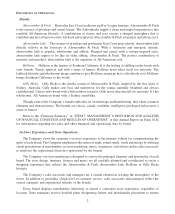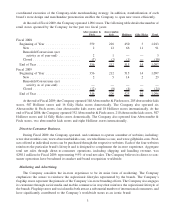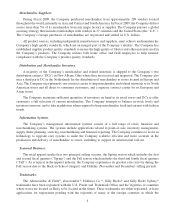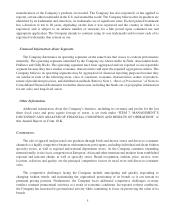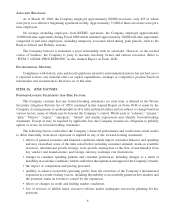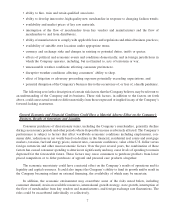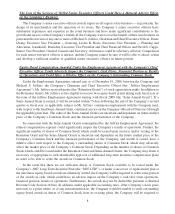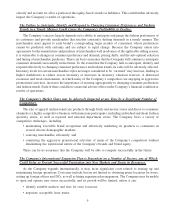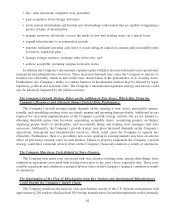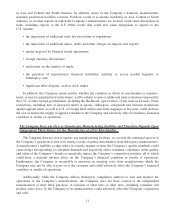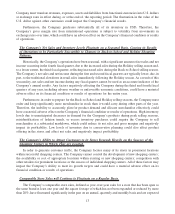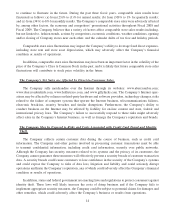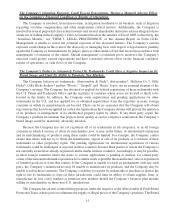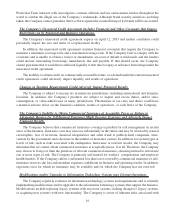Abercrombie & Fitch 2009 Annual Report Download - page 13
Download and view the complete annual report
Please find page 13 of the 2009 Abercrombie & Fitch annual report below. You can navigate through the pages in the report by either clicking on the pages listed below, or by using the keyword search tool below to find specific information within the annual report.
The Company’s Reliance on Two Distribution Centers Domestically Located in the Same Vicinity,
and One Distribution Center Internationally, Makes it Susceptible to Disruptions or Adverse
Conditions Affecting its Distribution Centers.
The Company’s two domestic DCs, located in New Albany, Ohio, manage the receipt, storage, sorting,
packing and distribution of merchandise to its stores and direct-to-consumer customers, both regionally and
internationally. The Company also uses a third-party DC in the Netherlands for the distribution of mer-
chandise delivered to its stores located outside of North America. As a result, the Company’s operations are
susceptible to local and regional factors, such as system failures, accidents, economic and weather conditions,
natural disasters, and demographic and population changes, as well as other unforeseen events and
circumstances. If the Company’s distribution operations were disrupted, its ability to replace inventory in
its stores and process direct-to-consumer orders could be interrupted and sales could be negatively impacted.
The Company’s Reliance on Third Parties to Deliver Merchandise from its Distribution Centers to
its Stores and Direct-to-Consumer Customers Could Result in Disruptions to its Business.
The efficient operations of the Company’s stores and direct-to-consumer operations depend on the
timely receipt of merchandise from the Company’s DCs. The Company delivers its merchandise to its stores
and direct-to-consumer customers using independent third parties. The Company uses primarily one contract
carrier for domestic store deliveries and all direct-to-consumer deliveries and a separate contract carrier for
international store deliveries. The independent third parties employ personnel that may be represented by
labor unions. Disruptions in the delivery of merchandise or work stoppages by employees or contractors of
any of these third parties could delay the timely receipt of merchandise. There can be no assurance that such
stoppages or disruptions will not occur in the future. Any failure by a third party to respond adequately to the
Company’s distribution needs would disrupt the Company’s operations and could have a material adverse
effect on its financial condition or results of operations. Furthermore, the Company is susceptible to increases
in fuel costs which may increase the cost of distribution which the Company may not be able to pass onto the
customer and could adversely affect the Company’s financial condition or results of operations.
The Company’s Development of New Brand Concepts Could Have a Material Adverse Effect on the
Company’s Financial Condition or Results of Operations.
Historically, the Company has internally developed and launched new brands that have contributed to
sales growth. The Company’s most recent brand is Gilly Hicks which offers bras, underwear, personal care
products, sleepwear and at-home products for women. Brand concepts such as Gilly Hicks require
management’s focus and attention, as well as significant capital investments. Furthermore, a new brand
concept is susceptible to risks that include lack of customer acceptance, competition from existing or new
retailers, product differentiation, production and distribution inefficiencies and unanticipated operating
issues. There is no assurance that a new brand concept, including Gilly Hicks, will achieve successful results.
The failure of Gilly Hicks or another new brand concept to be successfully launched could have a material
adverse effect on the Company’s financial condition or results of operations. In addition, the ongoing
development of new concepts may place a strain on available resources.
Fluctuations in Foreign Currency Exchange Rates Could Adversely Impact Financial Results.
The Company’s international subsidiaries generally use local currencies as the functional currency,
which includes Euros, Canadian Dollars, Japanese Yen, Hong Kong Dollars and British Pounds. The
Company’s Consolidated Financial Statements are presented in U.S. dollars (“USD”). Therefore, the
12


